Pekka Buttler, updated August 2025.
Basic Information on the T4/TX mount:
First off, the T4 (sometimes also referred to as T-4) and TX mounts are not precisely the same. Rather they are first- and second generation products that are mutually partially and somewhat compatible. Hence it makes sense to address both in the same article. Read on for more details.
Second, in speaking about the T4 mount, we’re actually talking about an early and a late version of the T4 mount, that are NOT mutually compatible. It is therefore more than slightly annoying that most online sources just say “T4” without going into details.
Third, the T4/TX mounts are not – strictly speaking – lens mounts as there has never been a camera that uses these mounts, but are instead intermediate mounts. The purpose of such mounts is to allow third party lens manufacturers to easily make their lenses usable on a wide range of camera bodies, simply by attaching a suitable adapter to the lens.
T4 / TX mount specifications
Mount type: Breech-lock (locking ring on lens) intermediate mount
Flange focal distance: 56,50 mm to base of breech-lock; 50,50 mm to edge of breech-lock ring (measured, approximate values)
Sensor Size: 36,0 mm x 24,0 mm (Full frame)
Mount communication:
• T4 lenses are able to respond to aperture stop-down commands and (on some systems) able to communicate the selected aperture.
• TX lenses are able to respond to aperture stop-down commands and (on all systems) able to communicate the selected aperture
The T4 intermediate mount – early and late versions.
In 1957 Tamron had started to manufacture camera lenses with the intention of these lenses being used on a wide range of cameras, using a thread-mounted intermediate mount, named simply the T-mount. That mount showed all third-party lens manufacturers the potential advantages of using intermediate mounts. Tamron followed up on that with the T2 mount, and the Adapt-a-Matic mount.
When Tamron’s competitor Tokina (see company profile) decided to launch their own intermediate mount in the late 1960s, they named it the T4 mount.
The T4 mount comes in two generations:
T4 early
Very much like the Tamron Adapt-a-matic1, the early version of the T4 mount is based on using an adapter that you stick on the rear of the lens, and then fasten it by turning a threaded fastening ring (this technically makes both these lens mounts breech-lock mounts).
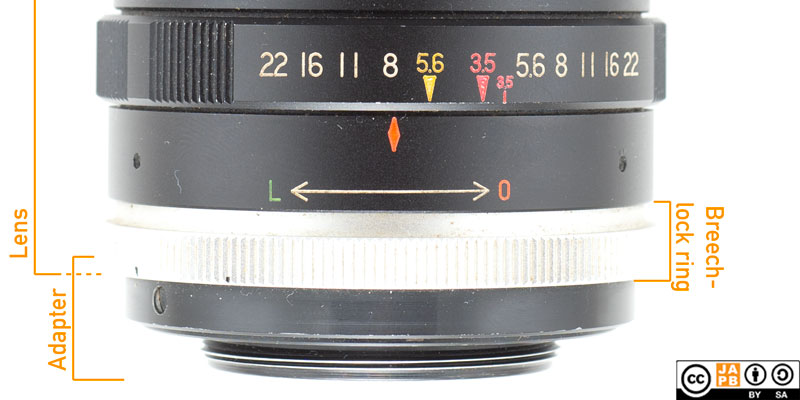
Note: L <——-> O to indicate direction of breech-lock ring and duplicated aperture scale on lens.
The T4 mount was from the beginning intended to allow auto aperture and even communicate the selected aperture (on some mounts), and as a specialty of the T4 mount, its aperture ring was designed to be operable in either direction. The adapter that you mounted mounted would determine if the smallest apertures were on the left or in the right (in the case of the M42 adapter above the smallest values were on left, but had you mounted for example a Konica AR adapter, the smallest values would have been on the right). Hence, Tokina figured out a way for overcoming what is known as the Contax-vs-Leica difference (and which other third party lens manufacturers struggled with)
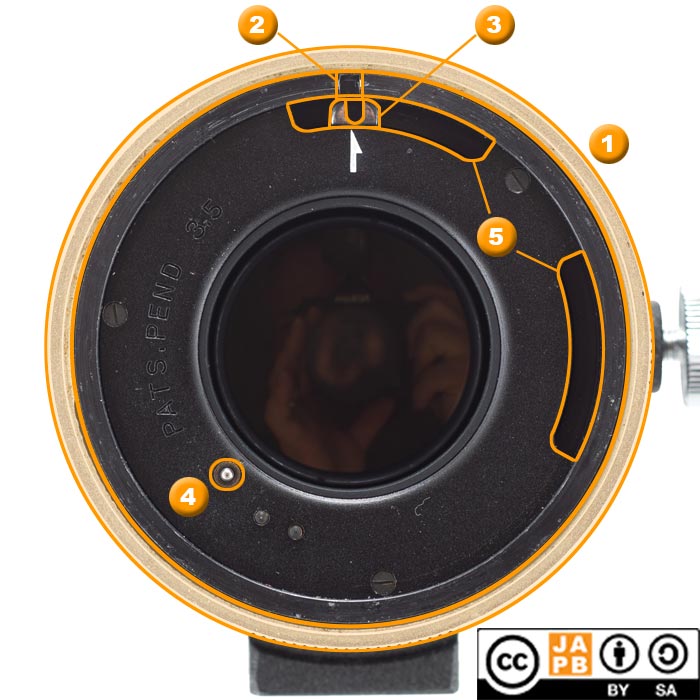
The T4 early mount and its elements:
[1] breech-lock ring, with threads on the inside. In absence of adapter, rotates freely.
[2] orientation notch at the top of breech-lock
[3] alignment fork, rotates together with aperture ring.
[4] aperture stop-down pin (release for the lens to stop down)
[5] openings for adapter to interact with alignment fork
But pretty soon2 Tokina would make one more change.
T4 late
Tokina decided to switch the way the breech-lock ring worked. Instead of having a threaded breech-lock ring that you had to twist and twist and twist (at a minimum 1,25 revolutions), Tokina implemented a ratcheted, short-throw breech lock instead.
That ratcheted breech-lock was ingenious, because you needed twist it for only 45° and because it created a breech-lock system that prevented accidental release (I’ve once dropped a Canon FD lens because I accidentally turned the breech-lock ring (and not the aperture ring).
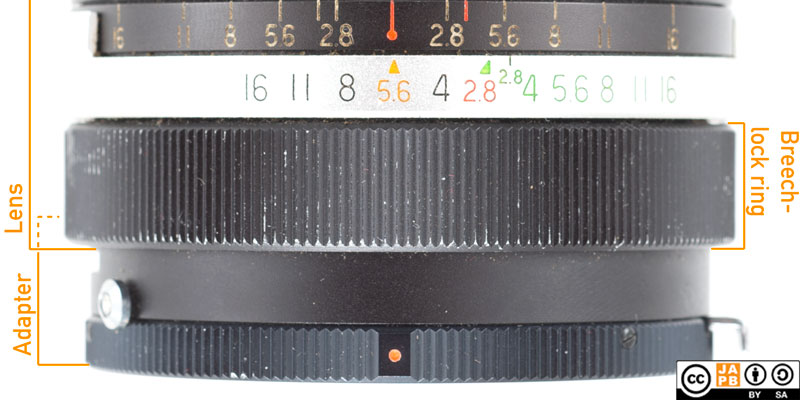
In a sideways view, the difference between T4 early and T4 late is not immediately visible. Yes, the breech-lock ring was wider and (typically) black, and the L <——-> O -markings attendant to the previous, threaded breech-lock ring were gone, but …
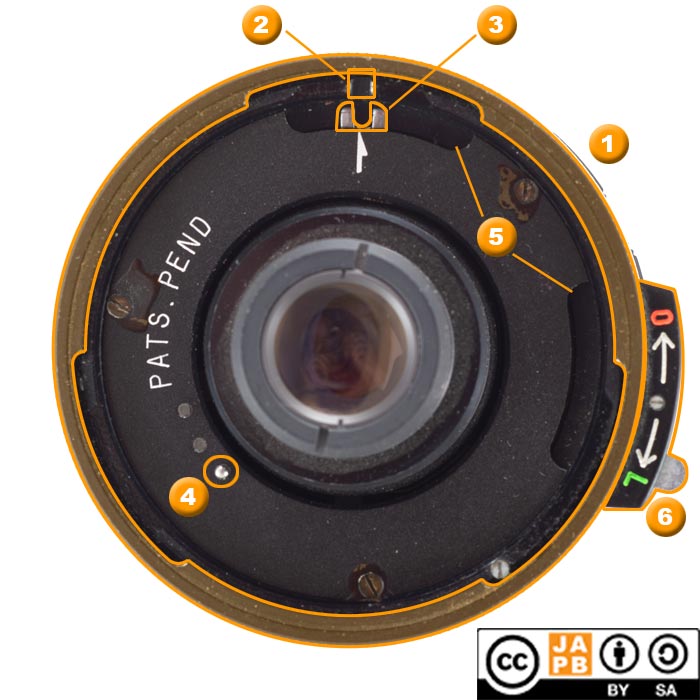
The T4 late mount and its elements:
[1] breech-lock ring, three openings for prongs on the adapter. (1 and 6 rotate together. Hence their angle vis-a-vis the lens barrel might vary)
[2] orientation notch at the top of breech-lock
[3] alignment fork, rotates together with aperture ring.
[4] aperture stop-down pin (release for the lens to stop down)
[5] openings for adapter to interact with alignment fork
[6] locking clamp with ratchet mechanism with arrows for O(pen) and L(ock). Silver tongue next to L must be pressed to unlock ratchet
Who sold T4 lenses?
All T4 lenses were manufactured by Tokina, but only relatively few of them were sold under the Tokina brand. Instead, these were lenses that Tokina manufactured to be sold by both Allied Photo Impex (Soligor) and Ponder & Best (Vivitar)
The TX intermediate mount
The TX-mount was introduced in the mid-70s to overcome the limitations of the T4 mount, namely the fact that T4 lenses were not able to communicate the selected aperture on all mounts. To achieve this, the lenses needed to be able to communicate selected aperture to the camera, using whatever method that lens mount supported3. This added some complexity to the adapter rings as well as the rear-end of the lens, but was handled rather ingeniously.
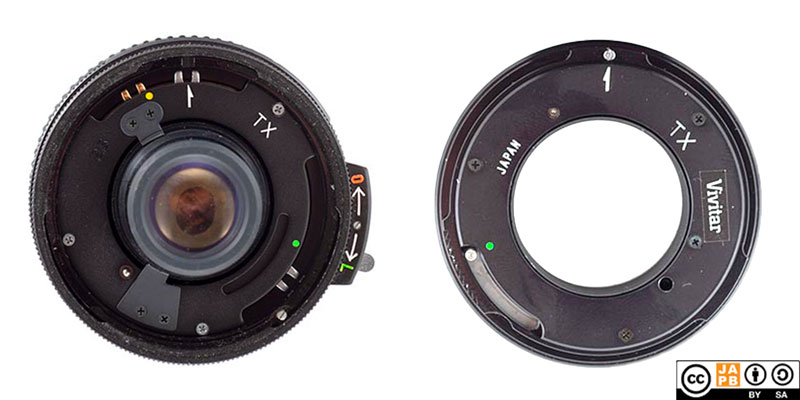
Right: TX-to Nikon F (Ai) adapter
The left image above shows three ‘forks’ as well as an orientation arrow, and two coloured orientation dots. The adapter on the right shows a coloured dot. Some adapters (such as the pictured) were made to be lined up with the green-coloured dot, others to be lined up with the yellow-coloured dot, still others for the white arrow dot. This way the ‘TX mount was able to accommodate a range of behaviours at the camera-end.
To mount the adapter, you were to start by turning the adapter’s aperture ring so that a fork lines up with the same coloured dot as your adapter. Next you insert the adapter so that the orientation arrows meet up.
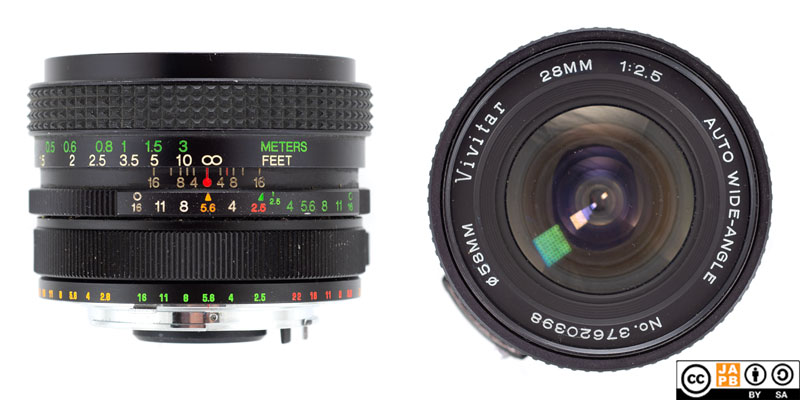
Note, please: Dual aperture range on aperture ring; several coloured apertures on base
Before going on, you would then rotate the ring on the bottom of your lens so that the aperture scale (readable in the camera’s Judas window) would correspond to the aperture range of the lens in question. Finally, you would press the locking clamp’s button and turn the clamp into the L-position.
If this mounting procedure feels cumbersome, indeed finicky, this was because the intention was never for adapters being regularly mounted/unmounted. Instead, the intention was for the adapter to be changed only by camera salesmen – once when the lens was being sold (and the buyer said they wanted it for a specific system) and maybe one more time (when the owner came with all their T-4/TX lenses to the camera shop in order to have them modified to the owner’s new camera system). For such a purpose, the adapter mounting procedure was more than simple enough (it necessitated no tools) and relatively foolproof.
Tokina had some success in producing lenses for intermediate mounts, but the increase of electronic lens-body communication and the advent of autofocus lenses forced Tokina to start producing their lenses separately for each mount.
What is noteworthy is that Tokina is one of the few third party lens manufacturers to have remained in the business, while many (most) others have had to throw in the towel.
Tokina TX lenses were sold only by Vivitar.
T4/TX interoperability
In the family of T4/TX mounts, there are three sets of lenses and adapters:
• T4 early (thread) lenses and adapters
• T4 late (ratchet) lenses and adapters
• TX lenses and adapters.
Importantly, you cannot use T4 early lenses or adapters with any of the later sets of lenses (or adapters) because they will simply not mount.
Regarding the interoperability of late T4 and TX gear, there are similarly imitations4. You cannot use a TX adapter on a T4 (late) lens as the adapter will likely not be able to mount. In most cases you can mount a late T4 adapter on a TX lens, and it will even ‘work’, but likely with some limitations.
Adapting T4/TX lenses
(Note: the following applies only partially to T4 early lenses. If you’re unsure of how your lens will work, be in touch).
If you intend to adapt your T4/TX lens to a dSLR…
There are original TX adapters to both Pentax K and Nikon F (Ai) available. These adapters allow you to use the T4/TX lens as if it was a native (manual focus) lens (including aperture and aperture priority exposure automation). There are also modern adapters available from several adapter manufacturers, but – in general – these adapters are dumb adapters and do not allow aperture control.
If your dSLR is a Canon EF or Sony/Minolta A or Four thirds camera, you are best served with a combination of an original T4/TX->Nikon adapter and an aftermarket dumb adapter ring to allow mounting Nikon F lenses on Canon EF / Sony/Minolta A / Four Thirds, but will have to manually control aperture.
If you intend to adapt your T4/TX lens to a mirrorless camera
If you already have a number of adapters from the typical SLR mounts to your mirrorless camera (e.g. Canon FD / m42 / Nikon F / Olympus OM / Pentax K …) your best choice is to get an original T4/TX adapter to whatever your most favoured SLR era lens mount is.
If you intend to adapt your T4/TX lens to a film SLR
Given the nature of the T-4/TX mounts, this is – with most cameras – relatively easy as a wide range of adapters were produced, including …
T4 adapters were made for: Alpa, Canon FL and FD, Contarex, Exakta/Topcon RE, Icarex BM5, Konica AR, Konica F, Leica R, LTM, M42, Minolta SR, Miranda, Nikon F (pre-Ai), Olympus Pen F, Petri FT, 16 mm C-mount
TX adapters were made for: Canon FL and FD, Contax/Yashica, Konica AR, M426, Minolta SR(MD), Nikon F (Ai and pre-Ai), Olympus OM, Pentax K.
If only a T4 adapter exists for your camera system, you can still use it on your TX lens. You will simply lose some functionality (that your camera could likely not make use of anyhow).
Footnotes
- I have not been able to ascertain with absolute certainty whether the Tamron Adapt-a-matic or T-4-early was introduced first. Both were introduced in the 2nd half of the 1960s. ↩︎
- Try as I might, I cannot give you a date on when this change was made, but based on the fact that late-type T4 lenses are very much more common, I’m guessing the early T4 variant did not last long. ↩︎
- Importantly, there are several methods for communicating the selected aperture from lens to camera body (lever outside mount, lever inside mount, pins and cams etc.), and each had its adherents and posed different challenges ↩︎
- Note please: The text in this paragraph is based on the experience I’ve made with the lenses and adapters that I have at hand. I have not been able to test every combination. ↩︎
- Normally available documentation does not mention this adapter, but I have seen one. ↩︎
- Note, please. There were both adapters to vanilla m42 mounts as well as some of the m42 variants (ar least Fujica, Mamiya and Pentax proprietary versions of the M42 mount). For details, see the JAPB article on the m42 mount. ↩︎